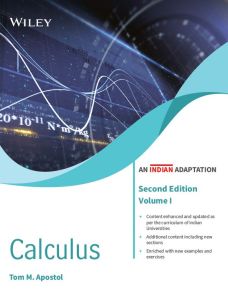Calculus, Vol I, 2ed (An Indian Adaptation)
ISBN: 9789354642630
For more information write to us at: acadmktg@wiley.com

Description
Calculus, Second Edition, strikes a perfect balance between theory and technique. Although it differs from the majority of contemporary texts, treating integration before differentiation is the most accurate historical representation of the relationship between the integral and the derivative. This introduces the mean-value theorems and their applications earlier in the text, incorporates a treatment of linear algebra, and contains many new and easier exercises. As in the first edition, an interesting historical introduction precedes each important new concept.
Introduction
Part 1. Historical Introduction
I 1.1 The two basic concepts of calculus
I 1.2 Historical background
I 1.3 The method of exhaustion for the area of a parabolic segment
I 1.4 Exercises
I 1.5 A critical analysis of Archimedes’ method
I 1.6 The approach to calculus to be used in this book
Part 2. Basic Concepts of Set Theory
I 2.1 Introduction
I 2.2 Notations for designating sets
I 2.3 Subsets
I 2.4 Set operations
I 2.5 Exercises
I 2.6 The inclusion-exclusion principle
Part 3. Axioms for the Real-Number System
I 3.1 Introduction
I 3.2 The field axioms
I 3.3 Exercises
I 3.4 The order axioms
I 3.5 Exercises
I 3.6 Integers and rational numbers
I 3.7 Geometric interpretation of real numbers as points on a line
I 3.8 Upper bound of a set, maximum element, least upper bound (supremum)
I 3.9 The least-upper-bound axiom (completeness axiom)
I 3.10 The Archimedean property of the real-number system
I 3.11 Fundamental properties of the supremum and infimum
I 3.12 Exercises
I 3.13 Existence of square roots of nonnegative real numbers
I 3.14 Roots of higher order. Rational powers
I 3.15 Representation of real numbers by decimals
Part 4. Mathematical Induction, Summation Notation

